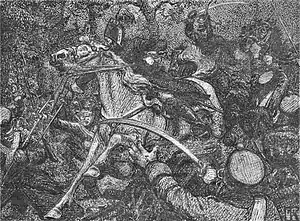| Battle of Ruona–Salmi | |||||||
|---|---|---|---|---|---|---|---|
| Part of the Finnish War | |||||||
 Adlercreutz i striden vid Salmi, by Nils Kreuger | |||||||
| |||||||
| Belligerents | |||||||
|
|
| ||||||
| Commanders and leaders | |||||||
|
|
| ||||||
| Strength | |||||||
|
Swedish sources: 4,700[2]–5,000[3] Russian sources: 7,000 regulars 5,000 militia 30 guns[4][1] |
Russian sources: 11,000,[4] of which 7,000 engaged[1] 58 guns[4] | ||||||
| Casualties and losses | |||||||
|
Swedish source (Adlercreutz): 170 killed 400 wounded 110 captured[3][2] Russian source: 1,500 killed or wounded[4] |
Russian sources: 845[2]–850[4] killed, wounded or captured | ||||||
The battle of Ruona–Salmi or the battle of Kuortane was fought between Swedish and Russian troops on 1–2 September 1808 at Ruona and Salmi, Kuortane. The Swedish army was led by Wilhelm Mauritz Klingspor with 4,700–5,000 men under his command (by Swedish sources; according to Russian sources, 7,000 regular soldiers and 5,000 irregular) against the Russian army of 11,000 men under the command of Nikolay Kamensky. The battle turned up to be a major engagement in the war where fierce artillery fire occurred from both sides. Kamensky, advancing from Alanus, beat back the Swedish barriers and on 31 August approached the Swedish army's position near Kuortane.[4]
Kamensky, having sent detachments under the command of Colonel Vlastov and Major general Kazachkovsky to bypass the enemy's flanks, attacked the Swedish troops on September 1 from the front by the vanguard of Russian troops under the command of Colonel Kulnev, and then by the detachment of Major general Raevsky. Despite the fierce and stubborn fight, which was held with varying success, the Swedes could not be pushed out from their positions. Meanwhile, detachments of Vlastov and Kazachkovsky bypassed the Swedish position and Klingspor, fearing being surrounded, in the night of September 2 retreated to the rear off Salmi village. In the morning Kulnev's 4,000 strong detachment defeated the Swedish rearguard and attacked the main Swedish positions from the front, while Kazachkovsky's detachment attacked from the rear. The enemy, pursued by Russian hussars, retreated in disarray to the north-west towards the town of Vaasa, unable to withstand the assault.[4]
The Swedes, who were in a well-fortified position, lost 170 killed, 400 wounded and 110 captured according to Adlercreutz, in addition several hundred men had fallen ill. Russian assessment suggests that Swedes lost up to 1,500 men. The Russians lost 128 killed, 648 wounded and 51 captured (excluding 18 officers) according to their own estimates. This battle is considered one of the turning points in the Finnish War along with the battle of Oravais.[3][2]
Citations and sources
Citations
Sources
- Hornborg, Eirik (1955). När riket sprängdes: fälttågen i Finland och Västerbotten, 1808-1809 (in Swedish). Stockholm: P. A. Norstedts och Söners Förlag.
- Velichko, Konstantin; Novitsky, Vasily; Schwartz, Alexey von; Apushkin, Vladimir; Schoultz, Gustav von (1915). Военная энциклопедия Сытина [Sytin Military Encyclopedia] (in Russian). Vol. XIV: Круковский – Линта. Moscow: Типография Т-ва И. Д. Сытина. pp. 399–400. Retrieved 17 July 2023.
- Yermolov, A. Y. (2016). "КУОРТАНСКОЕ СРАЖЕНИЕ 1808". Great Russian Encyclopedia. Electronic version. Retrieved 7 May 2023.